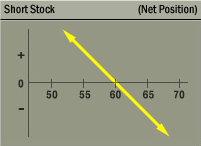Short Stock
A candidate for bearish investors who wish to profit from a depreciation in the stock's price.
Description
Selling stock short means borrowing stock through the brokerage firm and selling it at the current market price, which the short seller believes is due for a downturn. The plan is to buy the borrowed stock back later for less, allowing the investor to keep the difference between the two prices.
Individual investors often avoid this strategy because it involves many practical headaches. For example, the brokerage firm must approve the account for short sales. Then the position requires establishing an initial margin deposit and a readiness to shore it up whenever necessary. The short seller is also responsible for paying any dividends that occur during the time the stock is borrowed.
And if the stock becomes involved in a takeover transaction or undergoes a volatile period for any reason, it might increase the likelihood that the stock lender will demand the return of the stock. Covering the short means buying the stock at the market price, even if it results in large losses.

EXAMPLE
- Short 100 shares
MAXIMUM GAIN
- Selling price of stock
MAXIMUM LOSS
- Unlimited
Outlook
The investor is bearish either in the short term or the longer term, or both, and expects a definite decline in the stock's price.
Though the strategy does not involve a formal timetable as an option does, it may not be realistic to expect to be able to hold the position indefinitely. The investor is obligated to cover a short sale on very short notice, if asked.
Summary
Short stock is a candidate for bearish investors who wish to profit from a depreciation in the stock's price.
The strategy involves borrowing stock through the brokerage firm and selling the shares in the marketplace at the prevailing price. The goal is to buy them back later at a lower price, thereby locking in a profit.
Motivation
Profit dollar for dollar from a decline in the stock's price.
Bearish investors sell stock short primarily because they consider its market price to be significantly overvalued and due for a correction. If it is a standalone strategy (no other positions in the underlying), they are placing a great deal of capital at risk, so typically the opinion is strongly held.
Variations
N/A
Max Loss
The maximum loss is unlimited. The worst that can happen is for the stock to rise to infinity, in which case the loss would also become infinite. Whenever the position is closed out at a time when the stock is higher than the short selling price, the investor loses money.
The short seller does not want to see the stock rally. An increase in the stock's price can trigger a margin call to post additional funds on deposit. In addition to margin issues, the short seller has to be concerned about the stock lender asking for the stock to be returned. If the stock rallies sharply (say, because of an acquisition rumor), there is an even greater risk of the owner demanding the shares back. Covering the short at such a time could result in large losses.
Max Gain
The best that can happen is for the stock to become worthless. In that case, the investor can theoretically buy back the stock at no cost, return it to the stock lender, and keep the full initial short sale price.
Profit/Loss
The profit/loss characteristics are the inverse of the long stock position. The short stock position gains $1 for every $1 decline in the stock's value. Those gains are reduced by any dividend payments owed while the short stock position is held.
The potential profit is substantial. The maximum theoretical gain is reached if the stock's value falls to zero and there are zero dividends.
If instead the stock unexpectedly rises, potential losses are unlimited. Losses would track the stock's rise dollar-for-dollar.
Breakeven
This strategy breaks even when the stock is trading at the price received at the time of the short sale.
Breakeven = short selling price
Volatility
The concepts of volatility and especially implied volatility don't apply quite in the sense that they do to option positions. However, if the stock becomes more volatile, it increases the potential for larger losses as well as larger profits. Likewise, it affects the likelihood of having to meet margin calls. The chances of being asked to return the stock and cover the short position might increase, too.
Time Decay
Not relevant.
Assignment Risk
None.
Expiration Risk
None.
Comments
You will recall that the cost to carry a long stock position is a factor in that strategy. Likewise, cost to carry also matters in selling stock short, but the effect is the opposite. The short seller receives cash for selling someone else's shares, and it is typically deposited in an interest-bearing account. This income would help the net profit/loss. Dividends, if any, work against the positive effect, since it is the short seller's obligation to pay the dividends.
The investor's time horizon may be short or long, but the investor must realize there are no guarantees that the short position can be held indefinitely. The stock may be called back at the stock lender's discretion, which requires the short seller to return the stock, regardless of the cost of covering at that moment.
Short selling requires prior arrangements and a complete understanding of processes, rights and responsibilities.
Related Position
Comparable Position: Synthetic Short Stock
Opposite Position: Long Stock

